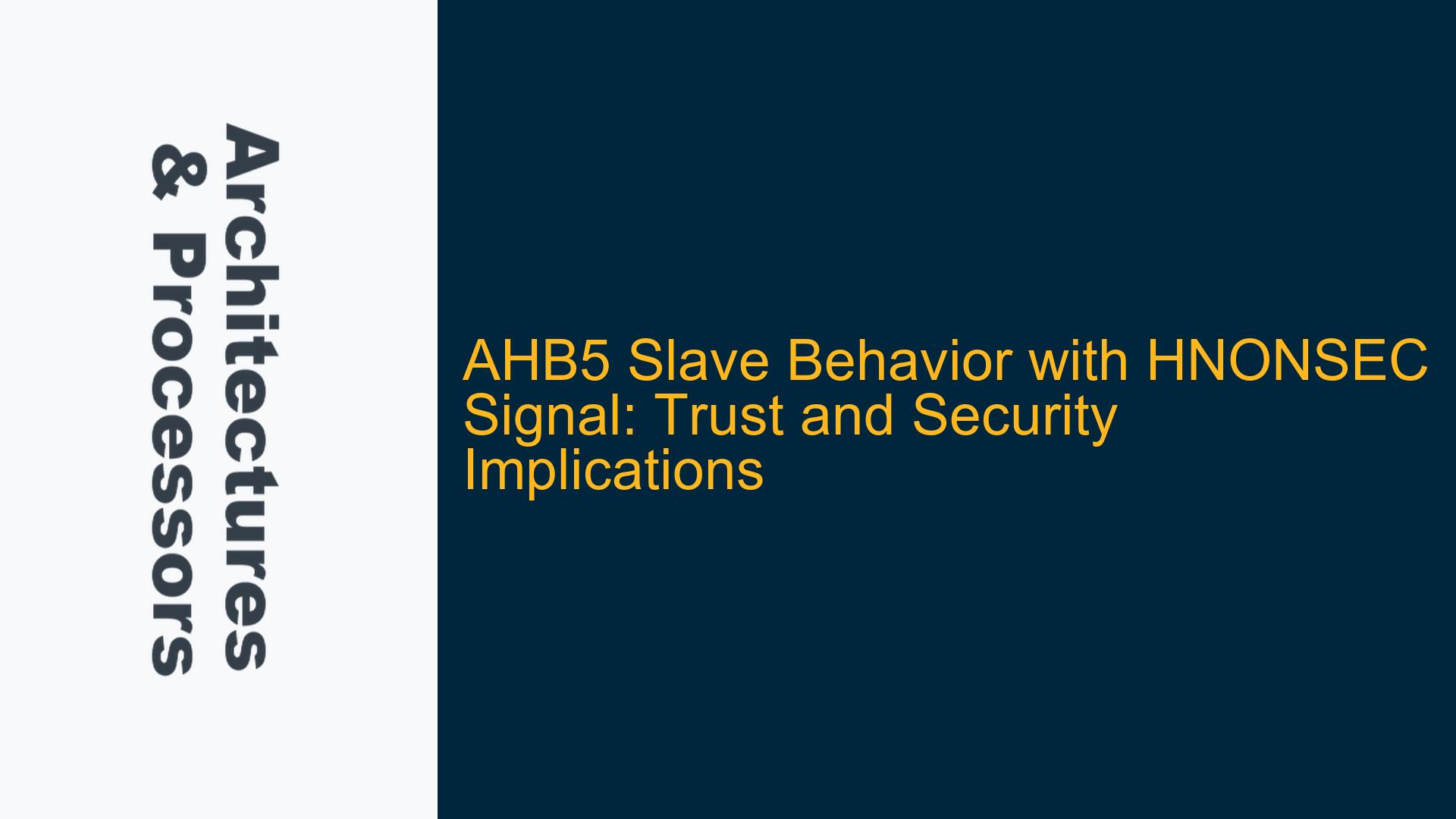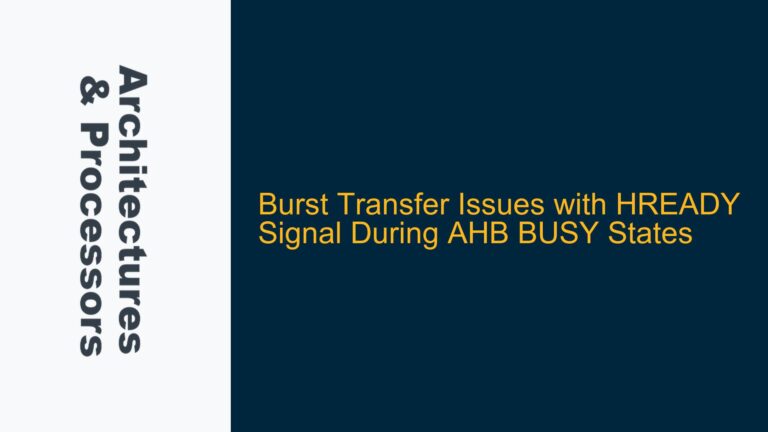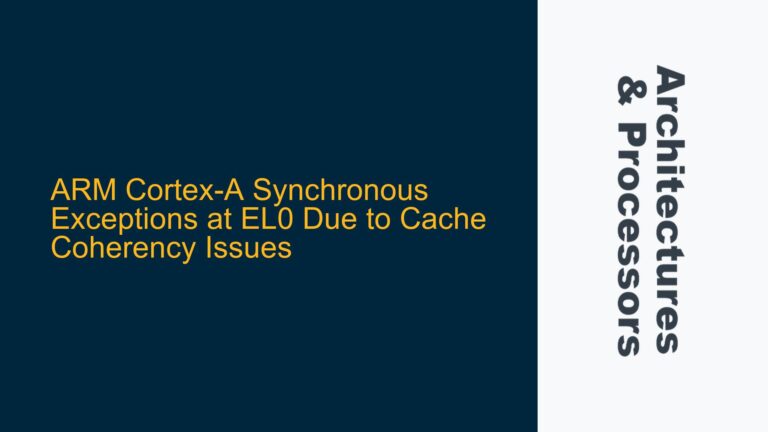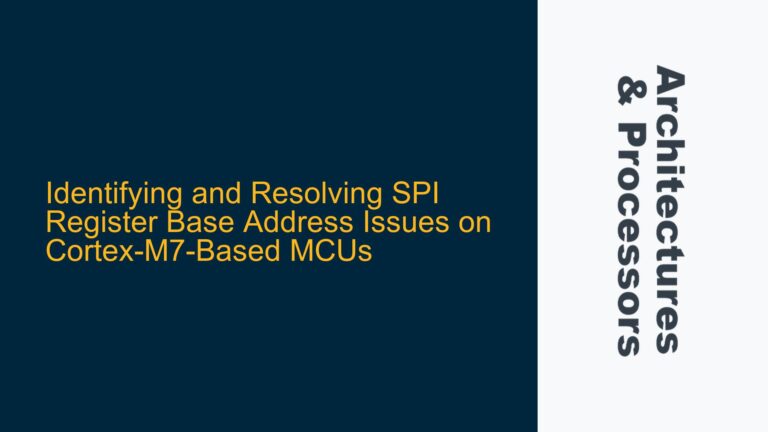AHB5 Slave Response to HNONSEC Signal in Trusted and Untrusted Scenarios
The behavior of an AHB5 slave when receiving transactions with the HNONSEC signal depends on whether the slave is a trusted peripheral or not, as well as the value of the HNONSEC signal itself. The HNONSEC signal is a critical component of the ARM AHB5 protocol, which is used to indicate whether a transaction is secure (HNONSEC = 0) or non-secure (HNONSEC = 1). The AHB5 slave must interpret this signal correctly to ensure proper security and functionality within the system.
When an AHB5 slave is a trusted peripheral, it is expected to handle both secure and non-secure transactions appropriately. For a trusted peripheral, if the HNONSEC signal is 0, the transaction is considered secure, and the slave should process it accordingly. If the HNONSEC signal is 1, the transaction is non-secure, and the slave should still process it but may apply additional checks or restrictions based on its internal security policies.
On the other hand, when an AHB5 slave is not a trusted peripheral, its behavior should be more restrictive. If the HNONSEC signal is 0, indicating a secure transaction, the untrusted slave should reject the transaction or raise an error, as it is not authorized to handle secure transactions. If the HNONSEC signal is 1, indicating a non-secure transaction, the untrusted slave can process the transaction, but it must ensure that it does not expose any secure resources or violate the system’s security policies.
The key challenge lies in ensuring that the AHB5 slave correctly interprets the HNONSEC signal and enforces the appropriate security measures based on its trust level. Misinterpretation or improper handling of the HNONSEC signal can lead to security vulnerabilities, such as unauthorized access to secure resources or incorrect processing of non-secure transactions.
Misconfiguration of Trust Zones and HNONSEC Signal Handling
One of the primary causes of issues related to the HNONSEC signal in AHB5 slaves is the misconfiguration of trust zones within the system. Trust zones define which peripherals and resources are considered secure and which are not. If the trust zones are not properly configured, an AHB5 slave may incorrectly interpret the HNONSEC signal, leading to improper handling of transactions.
For example, if a trusted peripheral is mistakenly configured as untrusted, it may reject secure transactions (HNONSEC = 0) that it should be able to process. Conversely, if an untrusted peripheral is incorrectly configured as trusted, it may process secure transactions, potentially exposing secure resources to unauthorized access.
Another possible cause is the improper handling of the HNONSEC signal within the AHB5 slave itself. The slave must have a clear understanding of its trust level and the security policies it needs to enforce. If the slave’s logic for interpreting the HNONSEC signal is flawed, it may fail to enforce the correct security measures, leading to potential security breaches or functional errors.
Additionally, the system’s interconnect fabric plays a crucial role in ensuring that the HNONSEC signal is correctly propagated to the AHB5 slave. If the interconnect fabric is not properly configured, it may incorrectly route transactions or fail to pass the HNONSEC signal, leading to incorrect behavior by the slave.
Implementing Secure Transaction Handling and Trust Zone Verification
To address the challenges related to the HNONSEC signal in AHB5 slaves, a systematic approach to implementing secure transaction handling and verifying trust zone configurations is essential. The following steps outline a comprehensive strategy for ensuring correct behavior:
-
Define and Configure Trust Zones: The first step is to clearly define the trust zones within the system. This involves identifying which peripherals and resources are considered secure and which are not. The trust zones should be configured in the system’s memory map and security controller, ensuring that each AHB5 slave is correctly classified as trusted or untrusted.
-
Implement HNONSEC Signal Handling Logic: Each AHB5 slave must implement logic to correctly interpret the HNONSEC signal based on its trust level. For trusted peripherals, the logic should allow both secure and non-secure transactions, applying any necessary security checks. For untrusted peripherals, the logic should reject secure transactions and only allow non-secure transactions.
-
Verify Trust Zone Configurations: Once the trust zones are defined and configured, it is crucial to verify that the AHB5 slaves are correctly interpreting the HNONSEC signal. This can be done through simulation and formal verification techniques. Simulation should include test cases that cover all possible combinations of trust levels and HNONSEC signal values, ensuring that the slaves behave as expected in each scenario.
-
Validate Interconnect Fabric Configuration: The interconnect fabric must be validated to ensure that it correctly routes transactions and passes the HNONSEC signal to the AHB5 slaves. This involves verifying that the fabric’s configuration aligns with the defined trust zones and that it does not introduce any security vulnerabilities.
-
Perform Security Audits and Penetration Testing: Finally, it is important to perform security audits and penetration testing to identify any potential vulnerabilities in the system’s handling of secure transactions. This includes testing for scenarios where an untrusted peripheral attempts to access secure resources or where the HNONSEC signal is manipulated to bypass security measures.
By following these steps, designers can ensure that the AHB5 slaves correctly handle the HNONSEC signal and enforce the appropriate security measures based on their trust level. This approach not only addresses the immediate challenges related to the HNONSEC signal but also contributes to the overall security and reliability of the system.
Detailed Analysis of AHB5 Slave Behavior with HNONSEC Signal
To further understand the behavior of AHB5 slaves with the HNONSEC signal, let’s delve into a detailed analysis of the different scenarios based on the trust level of the peripheral and the value of the HNONSEC signal.
Trusted Peripheral with HNONSEC = 0
When a trusted peripheral receives a transaction with HNONSEC = 0, it indicates that the transaction is secure. The peripheral should process the transaction as usual, applying any necessary security checks. Since the peripheral is trusted, it is authorized to handle secure transactions and access secure resources.
In this scenario, the AHB5 slave should:
- Validate the transaction against its internal security policies.
- Ensure that the transaction does not violate any access control rules.
- Process the transaction and provide the appropriate response to the master.
Trusted Peripheral with HNONSEC = 1
When a trusted peripheral receives a transaction with HNONSEC = 1, it indicates that the transaction is non-secure. The peripheral should still process the transaction, but it may apply additional checks or restrictions based on its internal security policies.
In this scenario, the AHB5 slave should:
- Validate the transaction against its internal security policies.
- Ensure that the transaction does not access secure resources.
- Process the transaction and provide the appropriate response to the master.
Untrusted Peripheral with HNONSEC = 0
When an untrusted peripheral receives a transaction with HNONSEC = 0, it indicates that the transaction is secure. Since the peripheral is untrusted, it is not authorized to handle secure transactions. The peripheral should reject the transaction or raise an error.
In this scenario, the AHB5 slave should:
- Detect that the transaction is secure (HNONSEC = 0).
- Reject the transaction or raise an error, indicating that it is not authorized to handle secure transactions.
- Provide an appropriate error response to the master.
Untrusted Peripheral with HNONSEC = 1
When an untrusted peripheral receives a transaction with HNONSEC = 1, it indicates that the transaction is non-secure. The peripheral can process the transaction, but it must ensure that it does not expose any secure resources or violate the system’s security policies.
In this scenario, the AHB5 slave should:
- Validate the transaction against its internal security policies.
- Ensure that the transaction does not access secure resources.
- Process the transaction and provide the appropriate response to the master.
Practical Implementation Considerations
When implementing the behavior of AHB5 slaves with respect to the HNONSEC signal, several practical considerations must be taken into account to ensure correct functionality and security.
Security Policy Enforcement
Each AHB5 slave must enforce the system’s security policies based on its trust level. This involves implementing logic to validate transactions against the defined security policies and ensuring that only authorized transactions are processed. The security policies should be clearly defined and documented, and the logic for enforcing them should be thoroughly verified.
Error Handling and Reporting
In scenarios where an AHB5 slave rejects a transaction due to security violations, it is important to provide clear and informative error responses to the master. This helps in debugging and identifying security issues during system integration and testing. The error responses should be consistent with the AHB5 protocol and provide sufficient information to diagnose the cause of the error.
Performance Considerations
The logic for handling the HNONSEC signal and enforcing security policies should be designed with performance in mind. Excessive latency or complexity in the security checks can impact the overall performance of the system. Designers should strive to implement efficient and optimized logic that minimizes the impact on transaction processing times.
Verification and Testing
Thorough verification and testing are essential to ensure that the AHB5 slaves correctly handle the HNONSEC signal and enforce the appropriate security measures. This includes both simulation-based testing and formal verification techniques. Test cases should cover all possible combinations of trust levels and HNONSEC signal values, as well as corner cases and edge scenarios.
Documentation and Traceability
Clear documentation and traceability are crucial for maintaining the integrity and security of the system. The design and implementation of the AHB5 slaves’ behavior with respect to the HNONSEC signal should be well-documented, including the rationale behind the security policies and the logic for enforcing them. Traceability matrices should be used to ensure that all requirements are met and that all test cases are covered.
Conclusion
The behavior of an AHB5 slave when receiving transactions with the HNONSEC signal is a critical aspect of system security and functionality. By understanding the implications of the HNONSEC signal and implementing appropriate logic to handle it based on the slave’s trust level, designers can ensure that the system operates securely and efficiently. Thorough verification and testing, along with clear documentation and traceability, are essential to achieving a robust and reliable implementation.






